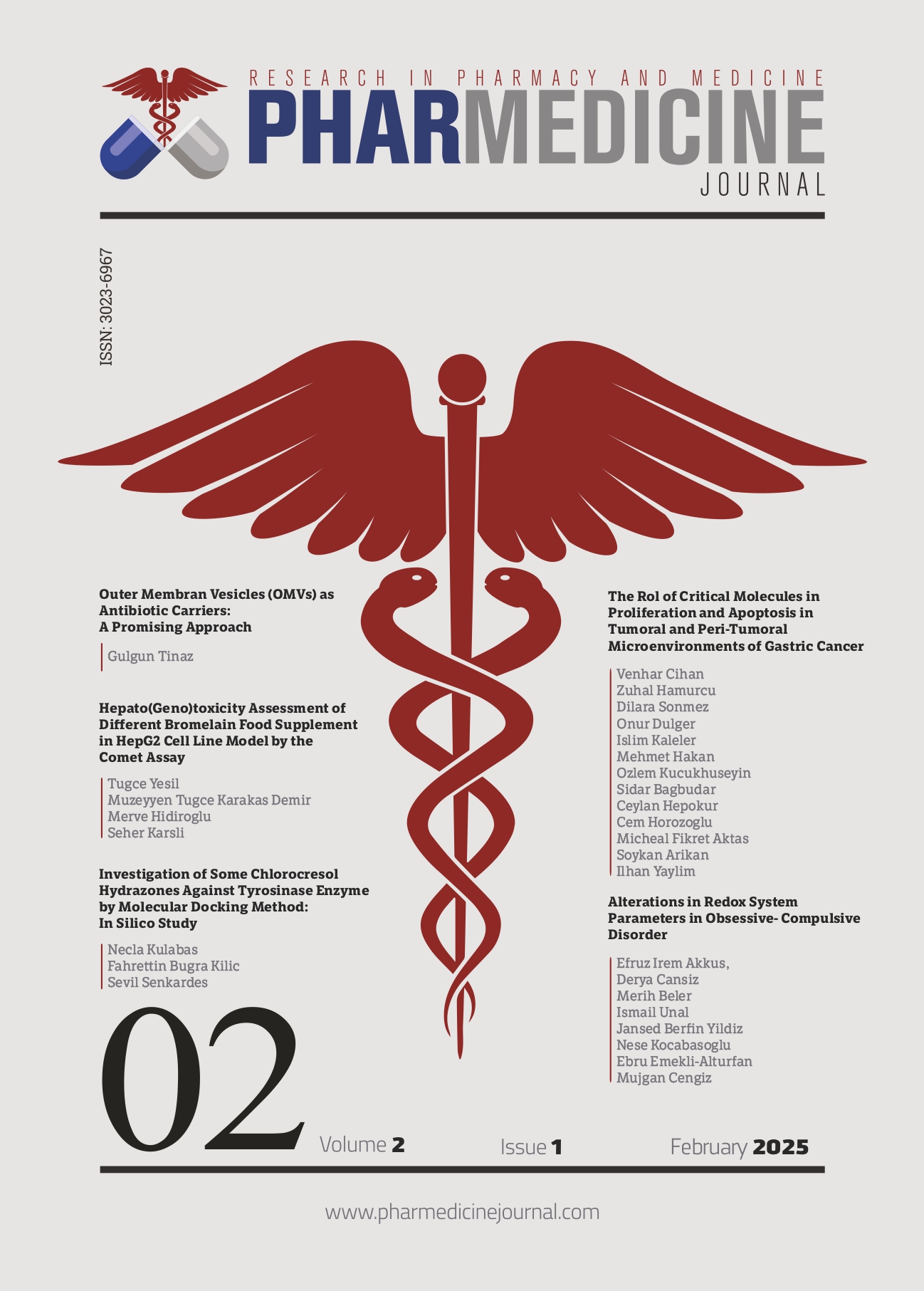Investigations of Some Chlorocresol Hydrazones Against Tyrosinase Enzyme by Molecular Docking Method: In Silico Study
DOI:
https://doi.org/10.62482/pmj.23Keywords:
p-chlorocresol, hydrazone, tyrosinase, docking, druglikenessAbstract
Introduction: Tyrosinase, found in various organisms, including plants and mammals, and is responsible for pigmentation as well as the undesirable browning of fruits and vegetables, is a multi-copper enzyme involved in the synthesis of melanin in human. As it is known, melanin provides protection against harmful ultraviolet radiation, which can lead to serious conditions like skin cancers. However, excessive melanin accumulation could result in hyperpigmented spots, creating aesthetic concerns. Tyrosinase inhibitors could potentially lead to the development of novel skin-whitening agents, anti-browning compounds for food preservation, and also for insect control substances. Recently, a wide spectrum of numerous moderate to potent tyrosinase inhibitors have been identified and reported.
Methods: In this study, by using the AutodockVina Virtual Screening Tool, some hydrazide-hydrazone compounds starting from p-chlorocresol were screened for interactions and binding mode of the tyrosinase active site. The enzyme-ligand interactions were analyzed using Biovia Discovery Studio software. Moreover, drug-likeness potential of the compounds was examined by using SwissADME online web tool.
Results: The results showed that compound S5, which did not violate the Lipinski and Veber rules and had a binding energy of -7.9 kcal/mol, could be a potential inhibitor of the tyrosinase enzyme.
Conclusion: Identifying the interactions between the tested ligands and the tyrosinase enzyme will contribute to the development of new hydrazide-hydrazone derivatives aiming the inhibition of tyrosinase.
References
Maddodi N, Jayanthy A, Setaluri V. Shining light on skin pigmentation: the darker and the brighter side of effects of UV radiation. Photochem Photobiol. 2012;88(5):1075-1082. https://doi.org/10.1111/j.1751-1097.2012.01138.x DOI: https://doi.org/10.1111/j.1751-1097.2012.01138.x
Brenner M, Hearing VJ. The protective role of melanin against UV damage in human skin. Photochem Photobiol. 2008;84(3):539-549.https://doi.org/10.1111/j.1751-1097.2007.00226.x DOI: https://doi.org/10.1111/j.1751-1097.2007.00226.x
Thawabteh AM, Jibreen A, Karaman D, Thawabteh A, Karaman R. Skin Pigmentation Types, Causes and Treatment- A Review. Molecules. 2023;28(12).
https://doi.org/10.3390/molecules28124839 DOI: https://doi.org/10.3390/molecules28124839
Karakaya G, Türe A, Ercan A, Öncül S, Aytemir MD. Synthesis, computational molecular docking analysis and effectiveness on tyrosinase inhibition of kojic acid derivatives. Bioorg Chem.2019;88:102950. https://doi.org/10.1016/j.bioorg.2019.102950 DOI: https://doi.org/10.1016/j.bioorg.2019.102950
Ebanks JP, Wickett RR, Boissy RE. Mechanisms regulating skin pigmentation: the rise and fall of complexion coloration. Int J Mol Sci. 2009;10(9):4066-4087. https://doi.org/10.3390/ijms10094066 DOI: https://doi.org/10.3390/ijms10094066
Varghese PK, Abu-Asab M, Dimitriadis EK, Dolinska MB, Morcos GP, Sergeev Y V. Tyrosinase Nanoparticles: Understanding the Melanogenesis Pathway by Isolating the Products of Tyrosinase Enzymatic Reaction. Int J Mol Sci. 2021;22(2). https://doi.org/10.3390/ijms22020734 DOI: https://doi.org/10.3390/ijms22020734
Guo L, Li W, Gu Z, Wang L, Guo L, Ma S, Li C, Sun J, Han B, Chang J. Recent Advances and Progress on Melanin: From Source to Application. Int J Mol Sci. 2023;24(5).
https://doi.org/10.3390/ijms24054360 DOI: https://doi.org/10.3390/ijms24054360
Zolghadri S, Beygi M, Mohammad TF, Alijanianzadeh M, Pillaiyar T, Garcia-Molina P, Garcia-Canovas F, Munoz-Munoz J, Saboury AA. Targeting tyrosinase in hyperpigmentation: Current status, limitations and future promises. Biochem Pharmacol. 2023;212:115574.
https://doi.org/10.1016/j.bcp.2023.115574 DOI: https://doi.org/10.1016/j.bcp.2023.115574
Şenkardeş S, Kucukguzel SG. Recent Progress on Synthesis and Anticancer Activity of 4-Thiazolidinone. Mini-Rev. Org. Chem. 2016;13(5):377-388.
https://doi.org/10.2174/1570193X13666160826154159 DOI: https://doi.org/10.2174/1570193X13666160826154159
Süzgün P, Şenkardeş S, Gürboğa M, Özakpınar ÖB, Küçükgüzel G. Synthesis and biological evaluation of new 4-thiazolidinone derivatives of flurbiprofen. Org Commun. 2023;16(1):11-23. https://doi.org/10.25135/acg.oc.144.2212.2653 DOI: https://doi.org/10.25135/acg.oc.144.2212.2653
Ali R, Marella A, Alam T, Naz R. Review Of Biological Activities Of Hydrazones. Indones J Pharm. 2012;23(4):193-202.
Padmini K, Preethi PJ, Divya M, Rohini P, Lohita M, Swetha K, Kaladar P. A Review on Biological Importance of Hydrazones. Int J Pharma Res Rev IJPRR. 2013;2(8):43-58.
Rollas S, Küçükgüzel ŞG. Biological activities of hydrazone derivatives. Molecules. 2007;12(8):1910-39. https://doi.org/10.3390/12081910 DOI: https://doi.org/10.3390/12081910
Şenkardeş S, Erdoğan Ö, Çevik Ö, Küçükgüzel G. Synthesis and biological evaluation of novel aryloxyacetic acid hydrazide derivatives as anticancer agents. Synth Commun. 2021;51(17):2634-2643. https://doi.org/10.1080/00397911.2021.1945105 DOI: https://doi.org/10.1080/00397911.2021.1945105
Ismaya WT, Rozeboom HJ, Weijn A, Mes JJ, Fusetti F, Wichers HJ, Dijkstra BW. Crystal Structure of Agaricus bisporus Mushroom Tyrosinase: Identity of the Tetramer Subunits and Interaction with Tropolone. Biochemistry. 2011;50(24):5477-5486.
https://doi.org/10.1021/bi200395t DOI: https://doi.org/10.1021/bi200395t
Morris GM, Huey R, Lindstrom W, Sanner MF, Belew RK, Goodsell DS, Olson AJ. AutoDock4 and AutoDockTools4: Automated docking with selective receptor flexibility. J Comput Chem. 2009;30(16):2785-2791. https://doi.org/10.1002/jcc.21256 DOI: https://doi.org/10.1002/jcc.21256
Stewart JJP. Optimization of parameters for semiempirical methods V: Modification of NDDO approximations and application to 70 elements. J Mol Model. 2007;13(12):1173-1213.
https://doi.org/10.1007/s00894-007-0233-4 DOI: https://doi.org/10.1007/s00894-007-0233-4
Hamdan M, Kulabaş N, Küçükgüzel İ. In silico Evaluation of H1-Antihistamine as Potential Inhibitors of SARS-CoV-2 RNA-dependent RNA Polymerase : Repurposing Study of COVID-19 Therapy. 2024;21(6):566-576. https://doi.org/10.4274/tjps.galenos.2024.49768 DOI: https://doi.org/10.4274/tjps.galenos.2024.49768
Allouche AR. Software News and Updates Gabedit-A Graphical User Interface for Computational Chemistry Softwares. J Comput Chem. 2012;32(2):174-182.
https://doi.org/10.1002/jcc.21600 DOI: https://doi.org/10.1002/jcc.21600
Kulabaş N. In silico investigation of novel 5-benzylidene-2- (arylsulfonylhydrazono)thiazolidine-4-ones as potential inhibitors of mPGES-1 and COX-2. J Res Pharm. 2023;27(5)(27(5)):2124-2134. https://doi.org/10.29228/jrp.491 DOI: https://doi.org/10.29228/jrp.491
Daina A, Michielin O, Zoete V. SwissADME: A free web tool to evaluate pharmacokinetics, drug-likeness and medicinal chemistry friendliness of small molecules. Sci Rep.2017;7:1-13. https://doi.org/10.1038/srep42717 DOI: https://doi.org/10.1038/srep42717
Downloads
Published
How to Cite
Issue
Section
License
Copyright (c) 2025 Necla Kulabaş

This work is licensed under a Creative Commons Attribution 4.0 International License.



